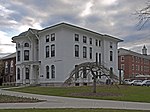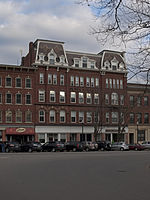Wyman Tavern
Buildings and structures in Keene, New HampshireHistoric house museums in New HampshireHouses completed in 1762Houses in Cheshire County, New HampshireHouses on the National Register of Historic Places in New Hampshire ... and 3 more
Museums in Cheshire County, New HampshireNational Register of Historic Places in Cheshire County, New HampshireTaverns in the American Revolution

The Wyman Tavern is a historic house, former tavern, and now a local history museum, at 339 Main Street in Keene, New Hampshire. Built in 1762 by Isaac Wyman, it also served as the muster ground for militia at the outbreak of the American Revolutionary War. In 1968 the property was acquired by a local non-profit, which leases it to the Cheshire County Historical Society for use as a museum. The building was listed on the National Register of Historic Places in 1972.
Excerpt from the Wikipedia article Wyman Tavern (License: CC BY-SA 3.0, Authors, Images).Wyman Tavern
Main Street, Keene
Geographical coordinates (GPS) Address Website Nearby Places Show on map
Geographical coordinates (GPS)
| Latitude | Longitude |
|---|---|
| N 42.925 ° | E -72.278333333333 ° |
Address
Keene State College
Main Street 229
03431 Keene
New Hampshire, United States
Open on Google Maps










